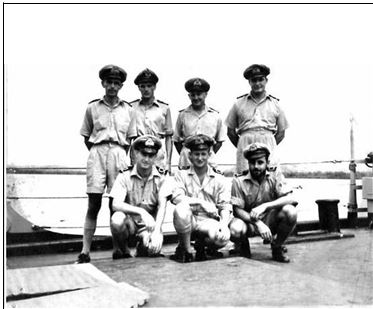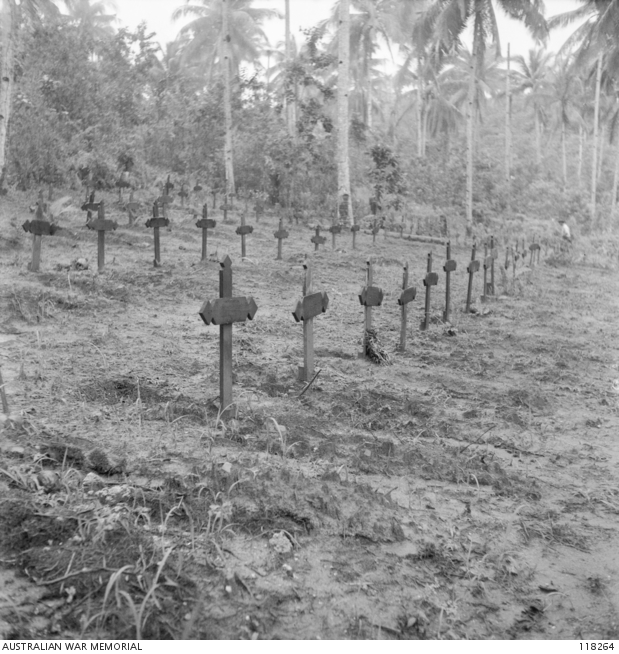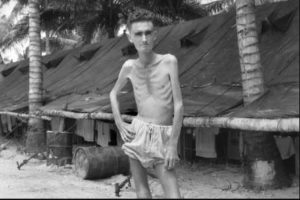- Author
- Editorial Staff
- Subjects
- Biographies and personal histories, WWII operations, History - WW2
- Tags
-
- RAN Ships
- HMAS Cootamundra, HMAS Latrobe, HMAS Glenelg, HMAS Junee
- Publication
- June 2022 edition of the Naval Historical Review (all rights reserved)
The late Arthur Lunan maintained a diary of his service in the RAN from 1941 to 1946. His brother-in-law William Moody digitised this and added some family photographs. William and his sister (Arthur’s widow) have given the Naval Historical Society permission to publish this material which is being serialised. This third and final part of the story covers Arthur’s service after leaving the Landing Ship Infantry HMAS Kanimbla and his final postings, mainly serving in HMAS Glenelg in New Guinea and the Dutch East Indies.
Beach Commando: ‘Neither one nor the other, but the best of both.’
After the last entry in his journal on 21 October 1944, Arthur left no written record of his remaining time in the navy, apart from some information contained in correspondence between himself and the Department of Defence in 1993 and 1994. The following is the record of his later postings, many of which are short administrative appointments to shore depots but often he was deployed elsewhere.
| Date from | Date to | Name | Type |
| 02 November 44 | 02 November 44 | HMAS Kuranda | Depot |
| 03 November 44 | 08 November 44 | HMAS Manoora | Ship |
| 09 November 44 | 16 November 44 | HMAS Penguin | Depot |
| 17 November 44 | 17 November 44 | HMAS Moreton | Depot |
| 18 November 44 | 19 November 44 | HMAS Kuranda | Depot |
| 20 November 44 | 21 November 44 | HMAS Magnetic | Depot |
| 22 November 44 | 29 December 44 | HMAS Kuranda | Depot |
| 30 December 44 | 30 December 44 | HMAS Moreton | Depot |
| 31 December 44 | 03 April 45 | HMAS Penguin | Depot |
| 04 April 45 | 16 September 45 | HMAS Madang | Depot |
| 17 September 45 | 13 January 46 | HMAS Glenelg | Ship |
| 14 January 46 | 20 January 46 | HMAS Leeuwin | Depot |
| 21 January 46 | 23 February 46 | HMAS Torrens | Depot |
| 24 February 46 | 02 April 46 | HMAS Rushcutter | Depot |
Considering the extremes to which he was exposed, this ‘record of service’ seems almost dismissive of the rigours and dangers he must have faced during these remaining months of the war, both at home and abroad. However, scrutiny of this correspondence together with research on the Australian War Memorial and National Archives websites reveals the true scope of his service during this period.
Extracts from Arthur’s letters reveal:
‘… I was in command of the first wave of landing craft onto Leyte.’ …
‘After the landings at Leyte, Central Philippines we returned to Milne Bay (N.G.) where I left the ship (Kanimbla) to take up an appointment with Naval Beach Commandos, 1 Aust. Beach Group, at Cairns. From 03 November to 08 November 1944 I was aboard HMAS Manoora awaiting passage to Australia. From 09 November to 17 November 1944 I was taking passage in USS Lurline to Brisbane. From 17 November I was at HMAS Moreton, then travelling by train to Cairns where I joined HMAS Kuranda on 23 November 1944.
‘On 29 November 1944 I proceeded to Trinity Beach and joined the Aust. Beach Group, was issued with full Army gear,and lived as an infantry soldier. After further training we finally

left Australia via Townsville on the US troopship David C Shanks. From 23 November 1944 to 17 September 1945 I was a member of Naval Beach Commandos attached to the Australian Beach Group (and again:) We embarked from Townsville and proceeded to Morotai then Borneo, where I landed with the second wave of the 2/17th Battalion on Brunei, British North Borneo. I remained with the RAN Beach Group until 17 September 1945’.
The RAN Beach Group (commandos) was a hybrid unit drawn from all branches of the services, highly trained operatives whose tasks were to go ashore with the first assault waves to establish the beachhead and prepare it for the safe landing of troops, ordnance and stores. They were also highly trained in all aspects of jungle warfare, including hand-to-hand combat.
Following the 10 June 1945 landings, it appears that Arthur remained embedded with the 2/17th Battalion during operations to recapture Borneo from the Japanese occupying forces. This battalion’s role in the operations saw them land on Brunei at Brooketon and participate in capturing the capital before dispatching companies to secure individual objectives in the outlying areas as the Australians advanced along the coast towards the oilfields at Seria. While any involvement by Arthur in land-based actions following the initial landings cannot be demonstrated, there is ample evidence from official war diaries that the 1st Beach Group as a whole continued to act as part of the ground forces: ‘Standing Orders’ for the ongoing conduct of the campaign were issued to all parties concerned, which included 1st Beach Group.
On 13 August 1945, the 2/17th Battalion received the order to cease offensive action. The bulk of the battalion remained deployed until the end of the month. During this time, they were involved in ensuring all Japanese forces in the area received the surrender instructions and complied with them. Allowing that Arthur ‘…remained with the 1st RAN Beach Group until 17 September 1945’ before then being posted to the corvette Glenelg the day after, it seems reasonable to assume that he was in fact actively deployed in Borneo with the 2/17th Battalion of the 9th Division for the three months between 10 June and 17 September 1945.
HMAS Glenelg
Apart from his Midshipman’s Journal, as with most things connected to his wartime service, Arthur left very little information regarding his time aboard Glenelg, with the crucial exception of one telling sentence from his correspondence with the Department of Defence:
‘.. Appointed to HMAS Glenelg for passage to Amboina as Assistant Port Director’.
Ambon
The island of Ambon was strategically important, being central to the spice trade, and before the founding of Batavia was the headquarters of the Dutch East India Company.
It was also the site of a major Dutch military base, which early in WWII Australia sought to strengthen in the face of a Japanese advance.
Gull Force, comprising 1131 troops largely made up of the Victorian 2/21st Battalion, plus numerous small detachments, sailed from Darwin in the Dutch coastal vessels Both, Patras and Valentyn escorted by HMA Ships Adelaide and Ballarat and landed at Ambon on 17 December 1941. In concert with Dutch and British troops they were involved in battle with a superior Japanese invasion force in early February 1942. Overwhelmed, the Allies surrendered, but in reprisal the Japanese massacred about 300 captured Australian and Dutch prisoners. The remainder were divided into two groups with 263 Australians and a similar number of Dutch being transported to a labour camp on the island of Hainan. The remainder, which included 532 Australians, were imprisoned on Ambon.
Following the Japanese surrender, of the 263 Australian prisoners at Hainan, 182 were still alive. These were returned to Australia in HMS Vindex and the hospital ship Jerusalemme. Of the 532 Australians that were imprisoned on Ambon only 123 were alive when rescued. It is also tragic that 12 prisoners, including the only Australian doctor, were killed in an American air raid on their camp. The survivors were taken to Morotai (where the Allies had established a base which included a hospital) in Glenelg and HMA Ships Cootamundra, Junee and Latrobe.


Conditions for prisoners on Ambon were horrendous and many died due to disease, starvation, and ill treatment. Thiscontributed to the highest death rate that Australians experienced in captivity. The Ambon War Cemetery holds nearly 2000 graves, including some reinterred from other outlying islands, mostly with the remains of Australian, Dutch and British servicemen. The cemetery evokes considerable emotion as it lies upon the site of the prisoner of war camp.
The following extracts are taken from unit histories regarding HMAS Glenelg‘s role at Ambon:
After the surrenders of the senior commanders (Japanese) had taken place in the first days of September, the situation at Ambon became favourable for the recovery of prisoners of war.
Ambon Surrender and Aftermath 8-22 September 1945
Moluccas (area headquarters) arranged for ships to be dispatched to Ambon to convey the Allied prisoners of war thence to Morotai. Glenelg (Lieut-Commander Whitebrook senior officer squadron), and Cootamundra, Latrobe and Junee sailed from Morotai at 8 pm on 8 September.
The force reached the rendezvous position, five miles off Tanjong Nusanive, the south-western extremity of Ambon, at 11.30 am on the 10th, and radio communication was established with Major Westley, commanding officer of Gull Force. At 11.55 am Lieutenant Nishida of the 21st Naval Guard Unit boarded Glenelg from a barge bearing the Japanese ensign and a white flag, and the force entered harbour and berthed alongside the main jetty where all the prisoners of war were waiting. Embarkation proceeded immediately contact had been made with Major Westley and Japanese officials.
After embarking 20 walking cases, Latrobe was detached to Piru Bay, Ceram, to embark two officers and 23 other ranks of the Indian Army who had been reported by Major Westley. The other three ships left Ambon at 5.45 pm on the 10th.’While passing Tanjong Nusanive’ Whitebrook noted in his report to NOIC Moluccas, ‘the ‘Still’ was sounded and colours half-masted as a tribute to those of Gull Force who had died in captivity.’
NOIC Moluccas, in his report to the Naval Board, remarked: ‘Of the total of 164 officers and men, some, including 38 stretcher cases, needed medical attention. The remainder were fit for normal travel, all were extremely emaciated, some men of twelve stone normal weight weighing only five stone. ‘
The 123 Australians were all that remained of the original Gull Force, the remainder having either died from malnutrition and disease or been beheaded. One AIF other rank died the day following arrival at Morotai.

The Japanese commander at Ambon was prepared to surrender to Whitebrook, but this was not accepted, since it was impossible to land an occupation party of a reasonable size. Occupation was carried out on 2 September. The naval force consisted of Glenelg (S.O.), Cootamundra, Junee and Latrobe, and HMA Ships Rockhampton, Birchgrove Park, Anaconda, Krait, Three Cheers, Nyanie, Westralia and Poyang. The occupation force comprised the 33rd Australian Infantry Brigade of 2705 officers and men, with Brigadier R. Steele in command.
1-27 September 1945 – Mothering the Sick
With an advance party of 110 AMF, Glenelg arrived at Ambon at 8 am on 22 September, and occupation proceeded without difficulty. Whitebrook assumed duties as Port Director. The remaining ships, carrying AMF troops and stores,mainly in HMAS Westralia, arrived in follow-up convoys which reached Ambon on 23 and 27 September. The formalities on the first day were performed smoothly. The Ambonese welcomed Glenelg, the Australian and Dutch flags were hoisted at the control tower of the wharf, and at 10 am Vice-Admiral Ichise, commanding the naval base, and Major-General Kobori, commanding the 5th Division, reported and were given instructions.
Next day the convoy arrived and the troops disembarked. That afternoon General Blamey’s proclamation was read in the presence of an assembly of Ambonese, and a bamboo-flute band performed. The follow-up force arrived on 27 September.
In between her two Ambon operations Glenelg as Senior Officer, with Rockhampton, Junee, Latrobe and HMAS Bowen, arrived at Menado on 14 September with an AMF and NICA Contact Team, and transported 334 internees, of whom 110 were women and 145 children, thence to Morotai. The operation was completed on 16 September. All those brought out from Menado were suffering badly from malnutrition. NOIC Moluccas, in his report, remarked:
’The crews of HMA Ships performed most admirably, and turned over their mess decks completely to the women and children. Very few of the crew had any sleep whatsoever. In addition, they mothered the women and children who were very seasick ‘.
This confirms the link between Arthur’s service record and the photographs from his own album that relate to that ship, the surrender of Japanese forces in Ambon in the Dutch East Indies (now Indonesia) and of Australian Prisoners of War:
The liberated survivors embarked on 10 September in the corvettes Glenelg, Cootamundra, Latrobe and Junee. Noel Grimes from Glenelg recalled: ‘Most of them were supporting each other, and their weight would have been in the old terms about five stone each. They were very weak, no meat, no flesh on them, and all were ulcerated’. From Morotai on 26 September they embarked in the hospital ship Wanganella which went on to Tarakan, Brisbane and then Sydney. The Victorians were then sent by hospital train to Junee and then on to Melbourne’s Heidelberg Repatriation Hospital.

From the AWM website:
‘In December 1944 Glenelg returned to Australia …. to commence a refit, which was completed in February. On 16 March she departed Sydney for Manus to resume operational duty. The remainder of the period to the close of hostilities was taken up chiefly by escort of Mortal and Biak convoys. In April she escorted a convoy to Leyte Gulf in the Philippines and spent some time in the Borneo area.
‘On 1 November she departed Ambon for Fremantle, via Morotai, Townsville, Sydney, Melbourne, and finally Glenelg, after which the ship had been named.’
This then completes the story of Arthur’s wartime journey that began with his enlistment in August 1942 and concluded with his demobilisation inApril1946:
August 1942 Cadet HMAS Cerberus (Flinders Naval Base), March 1943 Special Services:
HMAS Assault, January 1944 Midshipman HMAS Kanimbla Langemak Bay landings, March 1944 Acting Sub Leut. HMAS Kanimbla Megin Harbour Landings, April 1944 HMAS Kanimbla Tanahmerah Bay Landings, May 1944 HMAS Kanimbla Humboldt Bay Landings, June 1944 HMAS Kanimbla Wadke Island Landings, September 1944 HMAS Kanimbla Morotai Island Landings, October 1944 HMAS Kanimbla Leyte, Central Philippines Landings, November 1944 HMAS Kuranda (1st Beach Group), June 1945 2/17 Battalion Brunei British North Borneo landings, September 1945 HMAS Glenelg Ambon, January 1946 HMAS Torrens, February 1946 HMAS Rushcutter and April1946 – Demobilisation, Sydney.





